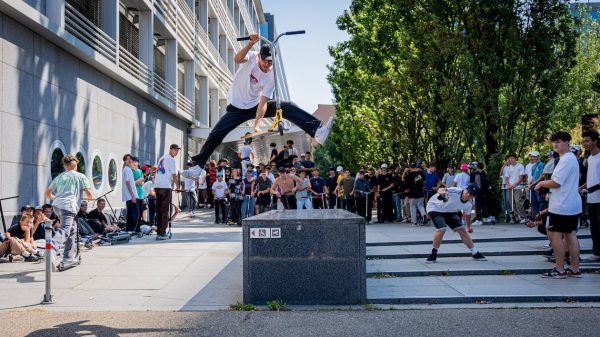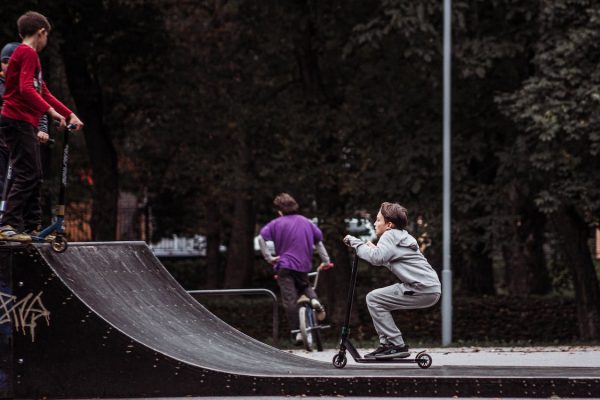We’ve all watched in awe as riders perform jaw-dropping stunts, flipping and spinning with ease. But have you ever wondered how these tricks are scores in competitions? There’s a lot more to it than meets the eye.
We’re here to guide you through the criteria used to score a scooter competition to help you understand the magic that takes place at the skate park. The scoring system at competitions considers several aspects of a rider’s performance and technical tricks, including trick difficulty, speed, execution and control, originality and style, use of the course, and consistency and progression. Each category may have a different point allotment. The same system is used for all riders in a contest.

Whether you are an aspiring competitor looking for insights before you bust out your best trick combos or simply a fan wanting to understand what goes on behind those scores at an event, let’s uncover the intricacies together! There are several factors judges typically consider: trick difficulty, execution and control, and originality and style.
We hope you enjoy learning about the fascinating world of scooter contests, and we would love to hear your feedback along the way.
Key Takeaways
Scoring a contest isn’t just about the difficulty of the tricks. It’s a blend of difficulty, execution, originality, use of course, and consistency. Judges look for riders who can combine all these elements seamlessly. They expect stunts that are done with style and finesse. So, whether you’re competing or just watching from the sidelines, remember it’s not just what you do but how you do it that makes a champion!
When competing in contests, riders are evaluated on a number of factors, such as trick difficulty, execution, originality, use of the course, and consistency. From flips to spins to grinds and slides, the key to success lies in mastering the tricks and using the right equipment to perform them safely and successfully. We will discuss all these points in this article.
The Basics Of Scoring Competitions
Scooter contests, especially stunt contests and freestyle scootering, can be exciting and rewarding! It may come as a surprise to learn that the basics of scoring in these events aren’t as complex as you might think. That said, every rider wants to get the best run. Judges allocate points based on execution, style, and variety. Despite potential biases among judges, it’s important to emphasize fairness for all participants to ensure these events are as enjoyable as possible.
With this in mind, the significance of difficulty should also be taken into account. With the right preparation and understanding of the competition rules and competition format, you can become equipped to face the challenge of these events and get a high score. So, why not give it a go and see what you can do?
The Importance Of Trick Difficulty
Don’t underestimate the importance of difficulty in these contests. It’s one of the key factors that can truly set you apart from other contestants and let you break the mold. We are here to provide valuable advice and insight into the trick difficulty and execution aspects of scooter contests.
Creative, original stunts are always preferred when it comes to difficulty. However, one must also consider the risk associated with higher-risk variations. Finding the balance between difficulty and feasibility is important when selecting tricks. Ultimately, difficult yet achievable tricks are the way to go.
Now, let’s dive into another crucial element – execution and control. To ensure success, it must be ensured that the rider has total control over their vehicle and can execute the trick in a safe and efficient manner.

Execution And Control
In our exploration, let’s now delve into two key aspects: the smoothness of the stunt and maintaining balance. When we talk about execution and control, it’s not just about pulling off a difficult trick; it’s also about how seamlessly and effortlessly we can make it flow. For example, two different riders may attempt the same trick combinations, but the execution might be different.
Similarly, keeping our balance throughout the entire maneuver is crucial; without it, even the most breathtaking tricks can end up in a messy tumble.
Smoothness Of The Scooter Trick
When it comes to competitions, smoothness is key. It’s not just about executing each move with style and grace but also about the fluidity of the trick. If the trick is executed with smooth lines and effortless maneuverability, it will show off the rider’s skill and impress the audience.
Maintaining balance is also integral to the performance, as it allows for smoother transitions without having to put your feet on the ground and ensures a stunning show. Whether you’re looking for an adrenaline rush with a freestyle scooter, a smooth ride with a manual scooter, or something in between, it’s important to remember that balance, maneuverability, and smoothness are key for a successful trick. So, be sure to keep these factors in mind as you hit the ramps and show off your skills.
Maintaining Balance
Mastering balance isn’t just about preventing falls; it’s the foundation that allows you to seamlessly transition from one move to another, enhancing your overall performance and making every ride a memorable experience. Balance also helps with your landing, if that’s something you’re struggling with.
With proper balance techniques, riders can execute complex stunts while maintaining stability and get rewarded accordingly. Balance recovery is essential in demonstrating control over the scooter.
Many riders enjoy showing off their originality and style while riding, which adds a level of excitement and spice to the activity. By mastering balance, riders can be confident in their ability to execute complex tricks and maintain stability, making every ride a success.
Originality And Style
Pushing the boundaries with your original stunts and personal style can set you apart from other competitors in a scooter trick competition. It’s about style evolution, creating a personal signature that reflects who you are as an individual and an athlete. Fostering creativity in the scooter world serves the sport and inspires others to push their limits. We believe in encouraging creativity and originality within the scooter community. We’d love to hear your feedback on how you push your own limits and share your unique tricks with the world.
When it comes to contests, the key is to use the course to your advantage. You should focus on mastering the course and creating a routine that showcases your skills. Utilizing various obstacles, ramps, gaps, and jumps can help you create a complex and creative routine that will wow the judges. Remember, it’s important to stay true to your own style and be creative, pushing the boundaries with your original tricks and personal style.
Use Of The Course
Let’s dive into another critical aspect: the use of the course. It’s not just about executing impressive stunts but also about how riders navigate the course with variety and creativity. Making effective use of obstacles demonstrates a rider’s skill, adaptability, and innovation in action.
Variety In Course Navigation
It’s not just about pulling off the coolest tricks. You’ve also got to show variety in course navigation!
Variety and creativity are both important when it comes to contests. Riders should explore different paths on the course, utilize varied ramp navigation techniques, make creative use of street elements, and switch between park and street styles. This approach keeps things interesting for spectators and experts alike and gives competitors the opportunity to show their unique style and skill.
Effective Use Of Obstacles
Navigating a course with variety is just half the battle. The real test lies in how effectively riders interact with obstacles, showcasing their obstacle creativity. In scooter trick competitions, judges observe how riders utilize every ramp, rail, and box to demonstrate their skills. This successful obstacle interaction requires talent and a keen awareness of one’s surroundings.
Scooter tricks, when performed correctly, can be a beautiful display of artistry. Additionally, they offer an opportunity to display one’s proficiency, creativity, and consistency when paired with other elements of the sport. Successful performance in a scooter trick competition also requires consistency and progression.

Consistency And Progression
If you’re a fan of scooters, you’ll be thrilled to know that consistency and progression are key to success in trick competitions. FamilyHype encourages you to push your limits and take risks every time you get on that scooter!
Judges are looking for riders who can manage risk and innovate with their tricks. Show them that you can flawlessly execute your stunts while adding your own unique spins. So, don’t just master the basics – strive for continuous improvement and dare to try something new! But, as always, make sure you follow the event’s guidelines.
Judging Scooter Competitions: Conclusion
In conclusion, judging scooter trick competitions isn’t just about the difficulty of the tricks. It’s a blend of difficulty, execution, originality, use of course, and consistency. Judges look for pro riders who can combine all these elements seamlessly. Remember, all riders must wear safety gear, whether they’re riding skateboards, scooters, or bikes.
Scooter tricks can involve flips, spins, grinds, and slides and are judged by an expert panel according to difficulty, execution, originality, use of course, and consistency. If you’re a competitive scooter rider committed to the grind, make sure to practice your tricks and use the right equipment to do them safely and successfully. Scooter events are a great way for parents to bond with their kids and the rest of the community.
Share your feedback with us at FamilyHype on how the judging criteria impacted your experience!
Frequently Asked Questions (FAQs):
How do you do a trick on a scooter?
This depends on the trick you want to attempt. However, you should start by making sure your scooter is capable of letting you complete the trick safely and correctly. Not all scooters can be used to do tricks.
What is the easiest trick on a scooter?
Some scooter tricks for beginners are the bunny hop, the wheelie, the tail grab, and the tail whip.
What is the no-footer trick on a scooter?
This trick involves taking both of your feet off the scooter and extending your legs out in mid-air.
What is the hardest trick on a scooter?
Some more challenging scooter tricks include the quad barspin, double backflip, the quint whip, and the backflip tail whip. It takes time to master difficult tricks, so keep practicing!
What is the difference between a kick scooter and a trick scooter?
Kick scooters and trick scooters have different handlebars. Trick scooters have a one-piece t-bar, which is strong enough to withstand the impact of performing stunts.
Which foot is dominant on a scooter?
This depends. But generally, your dominant scooter foot will be the foot you’d use if you were to kick a ball.
What is the proper scooter stance?
You should be leaning forward with your knees slightly bent. Your back should be straight but relaxed. Most riders put their non-dominant foot in front and their dominant foot at the back.
Can you do tricks on a scooter with big wheels?
Chances are, scooters with bigger wheels aren’t designed to be used for stunts. It is much safer to perform tricks using an actual trick scooter. As always, don’t forget to wear a helmet.
How do you go downhill on a scooter?
When going downhill, the main thing to remember is to lean back and shift your weight backward. You’ll also want to slow down since gravity will be doing a lot of the work.
Why do scooters have stunt pegs?
Stunt pegs are there to make it easier to perform tricks. In fact, certain tricks are impossible to perform without pegs.
DISCLAIMER (IMPORTANT): This information (including all text, images, audio, or other formats on FamilyHype.com) is not intended to be a substitute for informed professional advice, diagnosis, endorsement or treatment. You should not take any action or avoid taking action without consulting a qualified professional. Always seek the advice of your physician or other qualified health provider with any questions about medical conditions. Do not disregard professional medical advice or delay seeking advice or treatment because of something you have read here a FamilyHype.com.